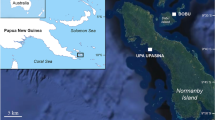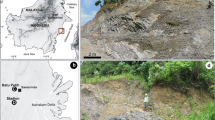Abstract
The effect of early diagenesis on Sr/Ca ratios encapsulated in coral skeletons was evaluated by comparing mineralogical, structural and geochemical characteristics of modern and Holocene, branching Acropora colonies. The modern specimens (Acropora danai, Acropora formosa) come from Réunion island (Western Indian Ocean) and the Great Barrier Reef of Australia respectively. The Sr/Ca ratios of modern specimens range from 9.08 to 9.37 mmol/mol. The fossil acroporids (Acropora group danai-robusta) were collected from a 50-m core drilled through a barrier reef in Tahiti island; their C-14 ages range from 3,200 to 10,200 calendar years B.P. Fossil skeletons are 100% aragonite. Earlier diagenesis has occurred in the marine environment; it is expressed by growth of secondary inorganic aragonite over primary skeletal aragonite needles, development of syntaxial aragonite cements within intraskeletal cavities and decrease in size of original 1–1,050-µm-wide pores (residual porosity ranges from 25 to 28%), which results in a volume reduction by 34 to 49%. Cementation increases with increasing age of the corals. Later diagenesis has occurred in a mixed marine–freshwater environment. It includes partial dissolution of skeletal and growth of cement aragonite fibres in the form of spherolites, irregular meshes of large squarely terminated laths; this results in an increase in porosity from 30 to 59%. By reference to modern well-preserved acroporids, this diagenetic alteration has led to an increase of Sr/Ca values (from 9.08–9.37 to 8.89–10.55 mmol/mol). This variation in Sr/Ca ratio can be linked to the increase in the amount of Sr-enriched cements relative to the volume of the skeletal aragonite and to a more homogeneous distribution of these cements throughout the skeleton. The uncritical use of Sr/Ca ratios as paleothermometers from diagenetically altered skeletons may cause serious misinterpretations. Accordingly, estimate of the degree of diagenetic alteration in skeletons is a prerequisite to any paleoclimatic reconstruction based on coral records.
Similar content being viewed by others
Author information
Authors and Affiliations
Additional information
Electronic Publication
Rights and permissions
About this article
Cite this article
Ribaud-Laurenti, A., Hamelin, B., Montaggioni, L. et al. Diagenesis and its impact on Sr/Ca ratio in Holocene Acropora corals. Int J Earth Sci 90, 438–451 (2001). https://doi.org/10.1007/s005310000168
Received:
Accepted:
Published:
Issue Date:
DOI: https://doi.org/10.1007/s005310000168




